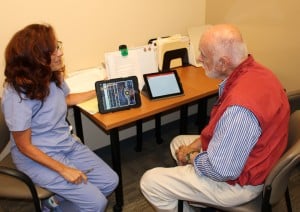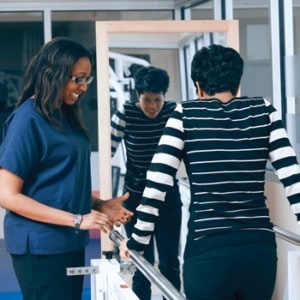Parkinson’s disease does not have a cure, but patients can improve their quality of life by addressing their symptoms.
A comprehensive approach with physical, occupational and speech therapy is the best option to help with walking, daily activities, communication and more.
Regional One Health’s Center for Rehabilitative Medicine features therapists who have special certifications to help Parkinson’s patients.
It’s true Parkinson’s disease is a progressive condition with no cure. But therapy can help improve the quality of life after a diagnosis.
Ambrosia Scott, DPT, LAT, CCI, is the outpatient rehabilitation manager for Regional One Health. She works with Parkinson’s patients at the East Campus Center for Rehabilitative Medicine.
“You can see improvement as patients make changes and become aware of what they need to do to overcome weakness and stiffness,” she said. “We can also adapt their environment with appropriate equipment and education for the patient and family members.”
Scott recommends a comprehensive approach with three types of therapy:
- Physical therapy
- Occupational therapy
- Speech therapy
“With Parkinson’s, everything goes from big to small,” Scott said. “All three disciplines work together to reach a successful outcome.”
Physical therapy
Physical therapy helps with large movements or gross motor skills.
Walking is a big focus. Parkinson’s patients can have a “scissor gate” due to stiff muscles. Their knees and thighs may hit or cross, like scissors. Their walking can become slow and shuffling.
Therapists work on several components:
- Balance
- Fluidity of movement and proper gait
- Posture
- Taking larger steps
- Coordinating arm swing with leg movement
Physical therapy can help with other motions as well, like getting positioned in bed. Scott has success with teaching patients “cues” to move their body a certain way. Adaptive equipment like walkers or devices to help pull into a sitting position also helps.
Occupational therapy
Occupational therapy addresses fine motor skills. Scott said the focus is on helping patients perform Activities of Daily Living. These include:
- Buttoning and unbuttoning clothes
- Writing
- Combing hair
- Brushing teeth
- Showering and using the bathroom
- Eating
Improving strength, flexibility and coordination can help. Patients also learn new ways to do things with or without adaptive equipment, Scott said.
Speech therapy
Speech therapy addresses weakness in the muscles that let people speak. Parkinson’s patients’ speech may become slurred or quiet due to weakness. That makes them hard to understand, so some stop talking altogether.

Regional One Health speech language pathologist Johnna Johnson uses the LSVT Loud program to help patients find their voice.
The Center for Rehabilitative Medicine offers the LSVT Loud program.
The proven program trains patients to use their voice at a normal volume. Therapists encourage patients to “think loud” and use exaggerated motions and behaviors. Patients also do exercises to strengthen their vocal cords and practice speaking audibly.
Easy access at the East Campus
At the East Campus, patients can access all three types of therapy in one convenient location. Therapists also communicate with each other to collaborate on each patient’s treatment program.
“Each discipline crosses over and coordinates in the care of the patient,” Scott said. “We all have the same goal, and we work together.”
